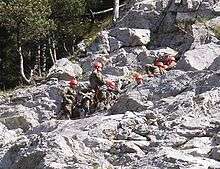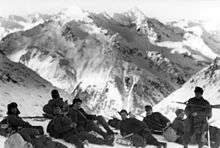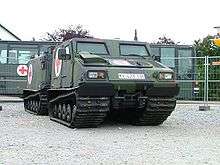Gebirgsjäger

Gebirgsjäger (German pronunciation: [ɡəˈbɪʁksˌjɛːɡɐ]) are the light infantry part of the alpine or mountain troops (Gebirgstruppe) of Germany and Austria. The word Jäger (meaning "hunter" or "huntsman") is a characteristic term used for light-infantry or light-infantryman in German-speaking military context.
The mountain infantry of Austria have their roots in the three Landesschützen regiments of the Austro-Hungarian Empire. The mountain infantry of Germany carry on certain traditions of the Alpenkorps (Alpine corps) of World War I. Both countries' mountain infantry share the Edelweiß insignia. It was established in 1907 as a symbol of the Austro-Hungarian Landesschützen regiments by Emperor Franz Joseph I. These troops wore their edelweiss on the collar of their uniforms. When the Alpenkorps came to aid the Landesschützen in defending Austria-Hungary's southern frontier against the Italian attack in May 1915, the grateful Landesschützen honoured the men of the Alpenkorps by awarding them their own insignia: the edelweiss. Together with the Fallschirmjäger (Paratroopers) they are perceived as the elite infantry units of the German Army.
Gebirgsjäger in World War II

During World War II the Wehrmacht and Waffen-SS raised a number of mountain infantry units.
An entire corps was formed in Norway by 1941. Its divisions were lightly equipped, with much of the transport provided by mules. These mountain infantry were equipped with fewer automatic weapons than regular infantry, however the MG 34 or MG 42 machine gunners were provided with more ammunition than their regular infantry counterparts.[1] Mountain infantry were identified by the edelweiss insignia worn on their sleeves and their caps.
Mountain infantry participated in many battles, including Operation Weserübung, Operation Silver Fox, Operation Platinum Fox and Operation Arctic Fox, the operations in the Caucasus, the Gothic Line, the invasion of Crete and the battles in the Vosges region of France. Special equipment was made for them including the G33/40 mauser rifle based on the VZ.33 rifle.
Heer (Army) Mountain units
- 1st Mountain Division (later 1st Volksgebirgs Division)
- 2nd Mountain Division
- 3rd Mountain Division
- 4th Mountain Division
- 5th Mountain Division
- 6th Mountain Division
- 7th Mountain Division (previously 99th Light Infantry Division)
- 8th Mountain Division (previously Division Nr. 157, 157th Reserve Division, 157th Mountain Division)
- 9th Mountain Division (previously Shadow Division Steiermark and Division zbV 140)
- 188th Mountain Division (previously Division Nr. 188, 188th Reserve Mountain Division)
Waffen SS Mountain units
- 6th SS Mountain Division Nord
- 7th SS Volunteer Mountain Division Prinz Eugen
- 13th Waffen Mountain Division of the SS Handschar (1st Croatian)
- 21st Waffen Mountain Division of the SS Skanderbeg (1st Albanian)
- 23rd Waffen Mountain Division of the SS Kama (2nd Croatian)
- 24th Waffen Mountain Division of the SS Karstjäger
Gebirgsjäger in the modern German forces
.svg.png)
Honouring tradition, upon the creation of the Bundeswehr in 1956, the mountain infantry returned as a distinctive arm of the West German army. Until 2001, they were organized as the 1. Gebirgsdivision, but this division was disbanded in a general reform. The successor unit is Gebirgsjägerbrigade 23 which has its headquarters in Bad Reichenhall. The battalions of these mountain infantry are deployed in southern Bavaria as this is the only high mountain area in Germany touching the Northern Alps. Since 2008 the unit is officially called "Gebirgsjägerbrigade 23 Bayern (Bavaria)" as a commendation of the close relationship between the state and the Gebirgsjäger.
According to the official Bundeswehr website, the brigade has a current strength of 6,500 soldiers.[2]
.jpg)
Traditions
The soldiers of the mountain infantry wear a grey cap (Bergmütze) with an edelweiß on its left side, stem to the front. This distinguishes them from all other German army soldiers who wear berets and the Austrian army, whose edelweiß has its stem to the back. The formal uniform, which is based on traditional alpine mountain climbing trekking outfits (Berganzug), is also different from the standard mainstream German army uniform, and consists of a light-weight grey ski blouse (Skibluse), black Stirrup trousers (Keilhose) or especially during the summer periods "Culottes" knee-breeches (kniebundhose) similar to knickerbockers, and ankle-height mountaineering boots (Bergstiefel) or dual-use mountaineering ski boots. A soldier is allowed to wear the edelweiß on the forage cap after he has completed the "Edelweißmarsch". This honor is only allowed for the mountain infantry.
German Gebirgsjäger traditionally share a very close comradeship and distinct esprit de corps. There is also a special perception of discipline which can for example be seen in a relatively informal relationship between officers and soldiers during normal day duty.
Tasks of the German Gebirgsjäger
The main tasks of the German mountain infantry are:
- Warfare in extreme weather conditions
- Winter warfare
- Warfare in urban terrain
- Warfare in arctic, mountain and desert terrain
Units
List of active mountain infantry in the Bundeswehr as of 2014:
- Gebirgsjägerbrigade 23
- Stab und Stabskompanie (HQ & HQ Company) in Bad Reichenhall
- Gebirgsjägerbataillon 231 (Mountain infantry battalion) in Bad Reichenhall
- Gebirgsjägerbataillon 232 (Mountain infantry battalion) in Bischofswiesen
- Gebirgsjägerbataillon 233 (Mountain infantry battalion) in Mittenwald
- Gebirgsaufklärungsbataillon 230 (Reconnaissance battalion) in Füssen
- Gebirgsfernmeldebataillon 210 (Mountain Signal battalion) in Bad Reichenhall and Bischofswiesen (to be disbanded; signal duties henceforth taken over by HQ Company)
- Gebirgspionierbataillon 8 (Combat engineer battalion) in Ingolstadt
- Gebirgslogistikbataillon 8 (Logistic battalion) in Füssen
- Einsatz- und Ausbildungszentrum für Gebirgstragtierwesen 230 (company-sized training center for transport mules) in Bad Reichenhall
- List of mountain units which are not part of the Gebirgsjägerbrigade 23:
- Gebirgs- und Winterkampfschule (international training center for mountain area and winter warfare) in Mittenwald
- Gebirgsmusikkorps (Mountain troops military band) in Garmisch-Partenkirchen. The Gebirgsmusikkorps is one of the most popular military bands in Germany. It performed for the ISAF in Kabul, Afghanistan in 2002.
As the Gebirgsjägerbrigade 23 is part of the so-called stabilisation forces (Stabilisierungskräfte), it lacks any accompanying artillery. Mortar support is provided by the Schwere Jägerkompanie (heavy infantry company) in every mountain infantry battalion.
Equipment and organization

A mountain infantry battalion consists of about 900 soldiers in five companies. One company is responsible for staff and support duties and has a "Hochgebirgsjägerzug" (special platoon for high mountain fight and reconnaissance) at its disposal. Three companies are consisting of classical mountain infantry, another one is a heavy company which is equipped with the Wiesel AWC for mortar support, tank defence and supporting cannon fire with 20 mm guns. Two of the three mountain infantry battalions are equipped with the Hägglund 206S, one with the GTK Boxer.
- Equipment of the Gebirgsjäger (selection):
- Wiesel AWC
- Bandvagn 206
- Snowmobiles
- Military versions of the Unimog
Gebirgsjäger in the modern Austrian forces
Today the traditions of the Austrian mountain infantry are maintained by the 6th Jägerbrigade in western Austria
Units
List of active mountain infantry in the Austrian Armed Forces as of 2013:
- 6th Jägerbrigade
- Brigadekommando (HQ) in Absam
- Stabsbataillon 6 (HQ battalion) in Innsbruck
- Jägerbataillon 23 (Mountain infantry battalion) in Bludesch
- Jägerbataillon 24 (Mountain infantry battalion) in Lienz
- Jägerbataillon 26 (Mountain infantry battalion) in Spittal
- Pionierbataillon 2 (Combat engineer battalion) in Salzburg
Notable members
Also see Alpenkorps for the World War I era unit.
- Karl-Theodor zu Guttenberg—German politician
- Hubert Lanz--General der Gebirgstruppe during World War II
- Prince Ludwig of Bavaria
- Edmund Stoiber—German politician
See also
| Wikimedia Commons has media related to Gebirgsjäger. |
- General der Gebirgstruppe
- Imperial-Royal Mountain Troops (Austria-Hungary)
- Jäger (infantry)
- Fallschirmjäger
Similar units
- Argentina: Cazadores de Montaña (Argentine Army)
- France: Chasseurs Alpins
- Italy: Alpini
- Poland: Podhale rifles
- Romania: Vânători de munte
- United States:
- Great Britain
- Royal Marines Commandos. Great Britain's Mountain & Arctic Warfare specialists
References
External links
- Lone Sentry: Some Notes on German Mountain Warfare (US WWII ...
- Articles, Pictures, Videostreams, Links (in German) about the Gebirgsjaeger
- Extensive web site dedicated to the history of Gebirgstruppen
- WWII Combat Footage from the Caucasus Mountains
- Informational Video from BWTV